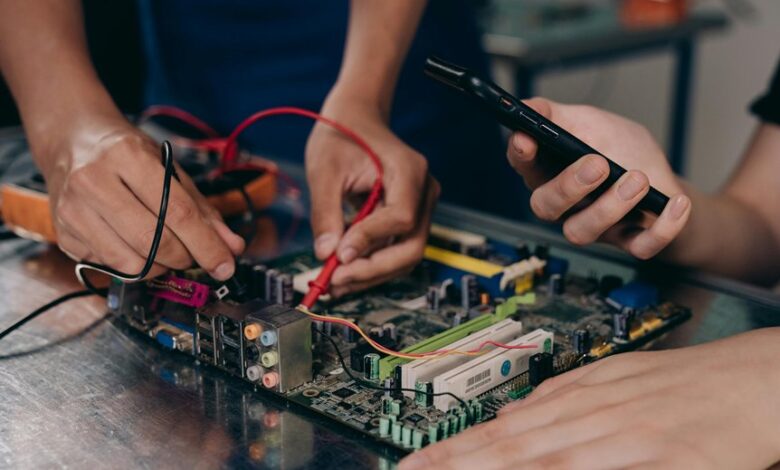
The Internet of Things (IoT) represents a significant advancement in how physical and digital realms interact. By employing sensors and connectivity, devices can autonomously exchange information, leading to improved efficiency across various sectors. This integration not only enhances user experiences but also raises critical questions regarding data security and privacy. As IoT continues to evolve, exploring its implications becomes essential for understanding its broader impact on society and technology.
The Evolution of IoT Technology
As the digital landscape has evolved, the Internet of Things (IoT) has emerged as a transformative force, fundamentally reshaping how devices communicate and interact.
IoT applications encompass smart cities and connected agriculture, leveraging edge computing and sensor networks. However, interoperability challenges persist.
Innovations in machine learning and real-time analytics enhance environmental monitoring, driving automation advancements and empowering users with unprecedented freedom in managing their ecosystems.
Smart Homes: Enhancing Daily Living
While the concept of smart homes may seem like a futuristic ideal, it has rapidly become a practical reality, integrating advanced technology into everyday living.
Innovations in smart energy management optimize resource consumption, enhancing efficiency and sustainability. Additionally, automated security systems provide unparalleled protection, offering homeowners peace of mind.
Together, these features create an intelligent environment that fosters autonomy and enhances the quality of daily life.
Wearable Devices: Tracking Health and Wellness
Wearable devices have emerged as pivotal tools in the realm of health and wellness, offering real-time monitoring of vital signs such as heart rate and blood pressure.
These innovations facilitate personalized fitness strategies by tracking physical activity and providing data-driven insights to enhance individual fitness goals.
As a result, the integration of IoT technology in wearables not only empowers users to take control of their health but also fosters a more proactive approach to wellness management.
Monitoring Vital Signs
A significant advancement in health monitoring technology has emerged through the integration of wearable devices, which facilitate the continuous tracking of vital signs such as heart rate, blood pressure, and oxygen saturation.
These devices enable remote monitoring, empowering users with real-time health analytics. This innovation fosters proactive health management, allowing individuals to make informed decisions that enhance their overall well-being and personal freedom.
Enhancing Fitness Goals
Building upon the advancements in health monitoring technology, wearable devices are also transforming the fitness landscape by enabling users to set, track, and achieve their fitness goals with unprecedented accuracy.
Key features of fitness tracking include:
- Real-time performance metrics
- Personalized goal setting
- Activity reminders
- Sleep quality analysis
- Integration with health apps
These innovations empower individuals to embrace their health journeys with newfound freedom and insight.
Industrial IoT: Transforming Business Operations
As industries increasingly adopt the Internet of Things (IoT), the transformation of business operations becomes evident through enhanced efficiency and data-driven decision-making.
Predictive maintenance, supply chain optimization, and smart manufacturing drive operational analytics. Asset tracking and remote monitoring improve workforce safety, while process automation fosters industrial connectivity.
Ultimately, these innovations enhance energy efficiency, creating agile businesses responsive to dynamic market demands.
Data Security and Privacy Concerns
The proliferation of connected devices in the IoT landscape introduces significant vulnerabilities, making data security and privacy paramount concerns.
Implementing robust cybersecurity best practices and prioritizing data encryption are essential strategies to mitigate risks associated with potential breaches.
Analyzing these aspects will provide a clearer understanding of how to safeguard sensitive information in an increasingly interconnected world.
Vulnerability of Connected Devices
Despite the transformative potential of the Internet of Things (IoT), the vulnerability of connected devices poses significant data security and privacy concerns.
Key issues include:
- Device exploitation through insecure protocols
- Network vulnerabilities leading to unauthorized access
- Firmware weaknesses facilitating data breaches
- Botnet threats leveraging compromised devices
- Ongoing privacy risks and compliance challenges
These factors necessitate urgent attention to security updates and protective measures.
Cybersecurity Best Practices
Recognizing the vulnerabilities inherent in connected devices highlights the pressing need for robust cybersecurity practices.
Implementing effective cyber hygiene, such as regular software updates and strong password policies, is essential.
Additionally, conducting comprehensive threat assessments allows organizations to identify and mitigate risks proactively.
Data Encryption Importance
While connected devices offer unprecedented convenience and functionality, they also expose sensitive data to various threats, making data encryption a critical component of IoT security.
Effective encryption algorithms are essential for ensuring secure transmission of data. Key considerations include:
- Protecting user privacy
- Preventing unauthorized access
- Maintaining data integrity
- Complying with regulations
- Enhancing consumer trust
These factors reinforce the necessity of robust encryption in IoT ecosystems.
The Future of IoT: Innovations on the Horizon
As the Internet of Things (IoT) continues to evolve, emerging innovations promise to redefine connectivity and automation across various sectors.
Autonomous vehicles will leverage real-time data integration for enhanced navigation and safety, while smart agriculture harnesses IoT for efficient resource management and crop monitoring.
These advancements signify a transformative shift toward a more interconnected, efficient, and sustainable future, empowering users through enhanced freedom and choice.
Conclusion
In conclusion, the Internet of Things stands as a digital tapestry, intricately woven with threads of connectivity that enhance our daily lives and transform industries. As IoT continues to evolve, it promises to unlock unprecedented innovations while addressing vital issues of data security and privacy. By bridging the physical and digital realms, IoT not only optimizes resource management but also paves the way for a smarter, more efficient future, where every device becomes a pivotal player in a vast network of intelligence.
